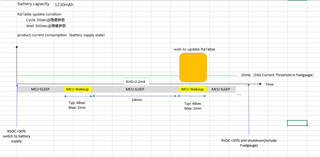Other Parts Discussed in Thread: BQSTUDIO
Hello TI engineers
BQ27426使用的阻抗跟踪算法,关于自学习部分,我们目前了解到的信息如下:
1. Qmax:在DOD累计变化超过35%的后,静置5小时或者OCV稳定后,采集OCV,并更新Qmax。
2. Ra Table:放电持续500s后,此后每 50 秒 计算一次,实时计算的阻抗 R(DOD, T)会存储在 RAM 里。每当 DOD 经过 这个些格点时,RAM 里的阻抗 R(DOD, T) 就会按公式(6)经过归一化处理,存储到 data flash,更新已有的阻抗表 Ra table: Ra 0 ~ Ra 14。
如果在如下的使用场景中,BQQ27426是否可以完成自学习,更新Qmax和Ra?
1. 电池仅用于供电电源断开的情况下使用,正常使用场景下,电池保持在不充电和不放电的场景下。
2. 在供电电源断开的情况下,电池会以0.2C放电1分钟,然后低功耗模式(10mA<dsg current threshold(15mA))维持30分钟;重复6次耗电约30mAh后关机。
The impedance tracking algorithm used by the BQ27426, regarding the self-learning part, we currently know the following information:
1. Qmax: after a cumulative change in DOD of more than 35%, after 5 hours of resting or after the OCV has stabilised, the OCV is collected and Qmax is updated.
2. Ra Table: After 500s of discharge and every 50 seconds thereafter, the impedance R(DOD, T) is calculated in real time and stored in RAM. Whenever DOD passes through this grid point, the impedance R(DOD, T) in RAM will be normalised according to equation (6) and stored in data flash, updating the existing impedance table Ra table: Ra 0 ~ Ra 14.
Can the BQQ27426 be self-learning and update Qmax and Ra in the following scenarios?
1. The battery is only used when the power supply is disconnected, and in normal use scenarios the battery is kept in a non-charging and non-discharging state.
2. With the power supply disconnected, the battery will discharge at 0.2C for 1 minute, then low power mode (10mA < dsg current threshold (15mA)) is maintained for 30 minutes; repeat 6 times to drain about 30mAh and then switch off.



